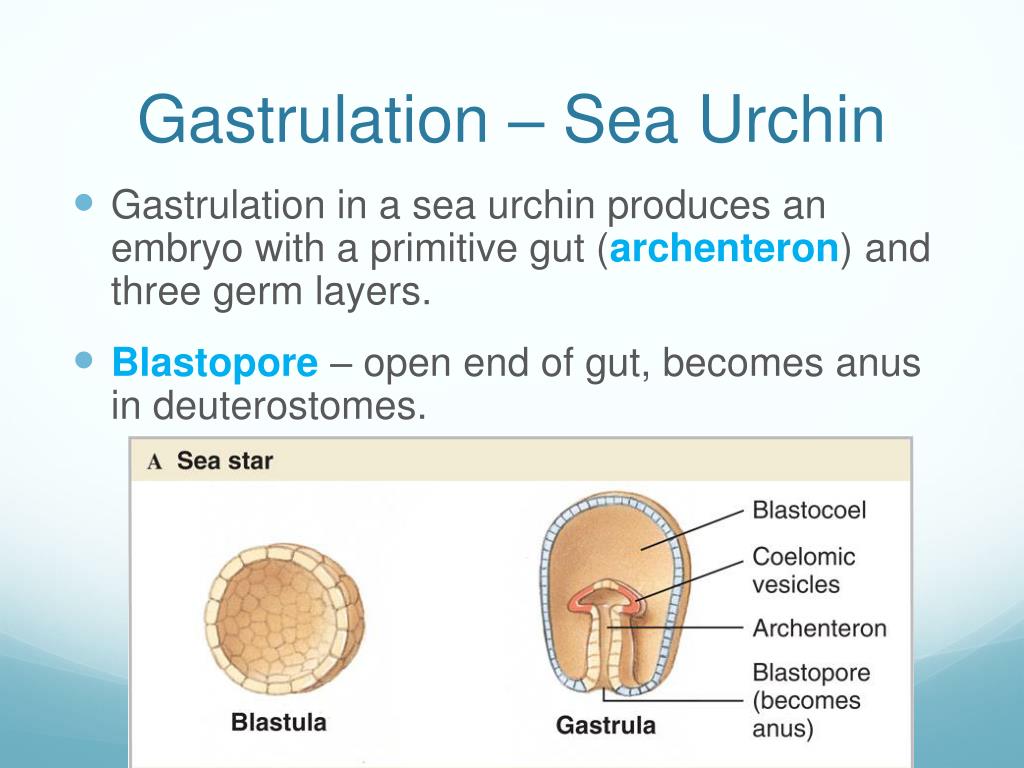
Deuterostomes have what is known as radial cleavage that is indeterminate. Protostomes have what is known as spiral cleavage which is determinate, meaning that the fate of the cells is determined as they are formed. In deuterostome development, the blastopore becomes the animal's anus. In protostome development, the first opening in development, the blastopore, becomes the animal's mouth. The major distinctions between deuterostomes and protostomes are found in embryonic development: Protostome derives from the Greek word protostoma meaning "first mouth" (πρῶτος + στόμα) whereas Deuterostome's etymology is "second mouth" from the words second and mouth (δεύτερος + στόμα). The distinction between protostomes and deuterostomes is based on the direction in which the mouth (stoma) develops in relation to the blastopore. Model organisms whose gastrulation is understood in the greatest detail include the mollusc, sea urchin, frog, and chicken. Furthermore, it is easier to study development in animals that develop outside the mother. Gastrulation has been studied in many animals, but some models have been used for longer than others. Gastrulation is highly variable across the animal kingdom but has underlying similarities. Lewis Wolpert, pioneering developmental biologist in the field, has been credited for noting that "It is not birth, marriage, or death, but gastrulation which is truly the most important time in your life." The terms "gastrula" and "gastrulation" were coined by Ernst Haeckel, in his 1872 work "Biology of Calcareous Sponges". Īlthough gastrulation patterns exhibit enormous variation throughout the animal kingdom, they are unified by the five basic types of cell movements that occur during gastrulation: įollowing gastrulation, cells in the body are either organized into sheets of connected cells (as in epithelia), or as a mesh of isolated cells, such as mesenchyme. In vertebrates, mesoderm derivatives include the notochord, the heart, blood and blood vessels, the cartilage of the ribs and vertebrae, and the dermis. The mesoderm gives rise to many cell types such as muscle, bone, and connective tissue. The endoderm gives rise to the epithelium of the digestive system and respiratory system, and organs associated with the digestive system, such as the liver and pancreas. The ectoderm gives rise to epidermis, the nervous system, and to the neural crest in vertebrates. Each layer gives rise to specific tissues and organs in the developing embryo. Gastrulation is followed by organogenesis, when individual organs develop within the newly formed germ layers. Gastrulation takes place after cleavage and the formation of the blastula. Sponges do not go through the gastrula stage, which is why they are basal among all animals. The two layers are also sometimes referred to as the hypoblast and epiblast. In diploblastic organisms, such as Cnidaria and Ctenophora, the gastrula has only ectoderm and endoderm. These three germ layers are known as the ectoderm (outer layer), mesoderm (middle layer), and endoderm (inner layer). In triploblastic organisms, the gastrula is trilaminar ("three-layered"). dorsal-ventral, anterior-posterior), and internalized one or more cell types including the prospective gut. 
Before gastrulation, the embryo is a continuous epithelial sheet of cells by the end of gastrulation, the embryo has begun differentiation to establish distinct cell lineages, set up the basic axes of the body (e.g. The possible significance of changes in the mode of association of the component cells on certain gross morphological changes of the sea urchin larva is discussed.Gastrulation is the stage in the early embryonic development of most animals, during which the blastula (a single-layered hollow sphere of cells) is reorganized into a multilayered structure known as the gastrula. In the larvae of irregular sea urchins, it is dissolved away.ĥ. After the migration of the primary mesenchyme cells from the blastular wall into the blastocoel, the vegetal hyaline layer which has been in contact with these cells is lifted up as folds in regular sea urchins. Moore's finding-hat at the time of hatching, the blastular wall, which has been permeable to cane sugar molecules, suddenly becomes impermeable to them-is confirmed.Ĥ. Raising the Ca level of the medium brings about a similar result, by causing a hardening of the hyaline plasma layer and thus preventing increase in size.ģ. Gum arabic prevents the fluid accumulation during early cleavage periods and reduces the volume of the segmentation cavity in later stages. It is shown that an increase in volume takes place in connection with each cleavage, and that the accumulated fluid comes around to the center of the larva, giving rise to the segmentation cavity.Ģ.

The accumulation of a fluid under the hyaline plasma layer of Strongylocentrotus pulcherrimus eggs, and its movement during cleavage and interkinesis are described.






 0 kommentar(er)
0 kommentar(er)
